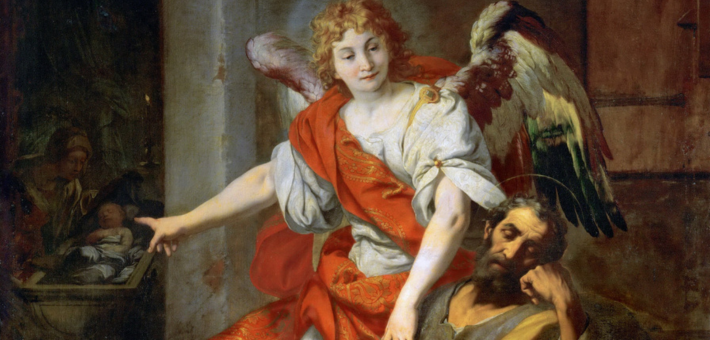Commentary on Matthew 2:13-23
In Judeo-Christian traditions, one expects God not to let evildoers prosper and not to let innocent people suffer. When this expectation is not met, the victim or the general public raises the question whether the God who allows such things to happen is just at all. It is called the theodicy question.
In Matthew, one of the most obvious places where the theodicy question should be raised is the infanticide by Herod the Great. When Herod heard a portent of the birth of a future king of the Jews, he decided to eliminate the threat. When his attempt at a targeted attack failed, he sent his soldiers and had them kill all the infants two years old and under in Bethlehem and its vicinity.
Matthew reports that Joseph had been pre-warned by the angel and had already taken the baby Jesus to Egypt to escape the massacre. This means Jesus would be the only baby in Judea whose life was spared because of God’s direct intervention, while all the other innocent babies unfortunate enough to be born in Bethlehem around the same time as Jesus perished.
Matthew narrates this tragic event in a matter-of-fact manner without raising the theodicy question.1 On the other hand, if this was a real historical event,2 I would say Matthew’s authorial decision to document the incident, in and of itself, could be seen as an act of protest against the autocratic abuse of power. If that is the case, it is a cautiously presented exposé of a heinous state crime committed by a corrupt tyrant.
After reporting the incident with no unnecessary details, Matthew cites a passage from Jeremiah 31:15 about Rachel weeping for her lost children (2:18–19). Rachel, as Jacob’s second wife in Genesis, is the mother of two sons, Joseph and Benjamin, but she never lived long enough to see her sons grow, let alone die (Genesis 35:16–20). That is, Rachel in Genesis never lost her children, to be able to grieve for them.
According to Jeremiah 40:1, Ramah is the temporary gathering place for the people of Judah who are being deported to Babylon after the fall of Jerusalem. Therefore, the weeping Rachel in Jeremiah’s oracle does not represent the original Rachel in Genesis. Rather, she symbolizes a matriarch of Israel who is weeping for the children of Israel, who are lost, metaphorically speaking, because of the imperial conquest by Babylon.
When this passage is cited by Matthew in the context of Herod’s infanticide, it offers the intended audience of Matthew a parallel imagery of two colonial powers wreaking havoc on the lives of innocent people in Israel: one by the Babylonian kingdom and the other by the Roman vassal kingdom of Herod.
This citation of Jeremiah’s oracle does much more than add one more piece to Matthew’s fulfillment theology, even though that is the primary function in this passage (verse 17). By summoning the weeping voice of Rachel, the Matthean text symbolically resurrects the then-forgotten voices of the grieving mothers who lost their newborn babies at the hands of Herod. That is something that no other historian of Matthew’s time had done. It is a belated and yet powerful protest against Herod as one of the puppet kings of the Roman Empire.
With this intertextual allusion to the past event through the Jeremiah citation, Matthew raises the question of theodicy in his own way—that is, in poetic language, if not with explicit statements. The cited cry of Rachel is not just a sound of wailing, but it has a clear message. It is a cry for justice that is not being served.3
Still, a troubling question remains regarding Matthew’s treatment of Jesus as the only one whose life was preserved by God’s deliverance. Is Matthew expecting his audience just to be content that the baby Jesus survived the massacre? How are Matthew’s readers supposed to feel about the fact that Herod lived a long and fortunate life without being held accountable for his massacre of the Bethlehem babies and for any other atrocities he had committed?4 The answer might lie hidden underneath the surface of the text, to be discovered only through perceptive reading.
This story of Herod’s infanticide has an intra-textual connection to the Parable of the Sheep and Goats (Matthew 25:31–46), which is the conclusion of the last of the five major discourses of Jesus in Matthew (chapters 24–25).
Jesus, the eschatological judge, separates all the people between the right and the left. He calls the former the righteous/just and the latter the accursed. The just will receive eternal life while the unjust will go to eternal punishment. It is remarkable that the single criterion for the verdict of Jesus is how one treated the least ones in the world. The “least” in this parable are illustrated as the hungry, the thirsty, the foreigners, the naked, the sick, and the captives (verses 35–36). Comprehensively, they can be called the smallest people who have no power or protection.
The slaughtered infants in our passage are a small fraction of all the “least” in the Parable of the Sheep and Goats, but certainly they are included in that category, as they are literally the smallest ones. In this scenario, Herod will be among the first to be condemned by Jesus and sent to eternal punishment. Neither during the time of Jesus nor that of Matthew’s composition was justice served against Herod’s infanticide, but through Jesus’ farewell sermon, Matthew gives a dire prediction that it will surely be served in the ultimate eschatological judgment.
Notes
- Ulich Luz, Matthew 1–7 (Fortress, 2007), 121.
- Many scholars doubt the historicity of this story on account o,f the lack of corroborating evidence elsewhere.
- For a fuller exegesis on this point, see Eugene Park, “Rachel’s Cry for Her Children: Matthew’s Treatment of the Infanticide by Herod,” CBQ 75 (2013): 473–85.
- Josephus, Antiquities of the Jews, 17.8.1, notes how fortunate Herod was to have lived a long life in spite of all the dangers threatening him because of the many barbaric acts he had committed.



December 28, 2025